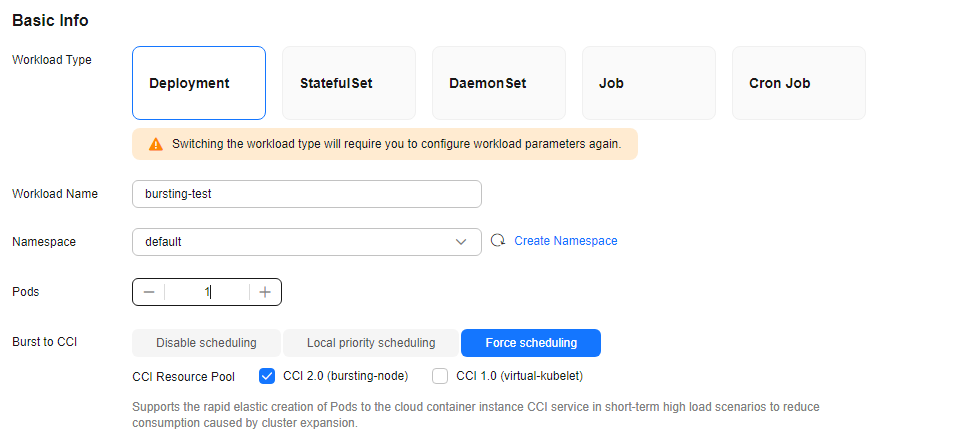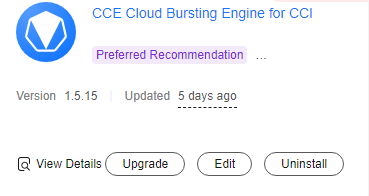Elastic Scaling of CCE Pods to CCI
The bursting add-on functions as a virtual kubelet to connect Kubernetes clusters to APIs of other platforms. This add-on is mainly used to extend Kubernetes APIs to serverless container services such as Huawei Cloud CCI.
With this add-on, you can schedule Deployments, StatefulSets, jobs, and CronJobs running in CCE clusters to CCI during peak hours. In this way, you can reduce consumption caused by cluster scaling.
Prerequisites
- Before using the add-on, go to the CCI console to grant CCI with the permissions to use CCE.
- VPC endpoints have been purchased for using the CCE Cloud Bursting Engine for CCI add-on. For details, see Environment Configuration.
Constraints
- Only CCE standard and CCE Turbo clusters that use the VPC network model are supported.
- The CCE Burst Elastic Engine (CCI) add-on earlier than v1.5.37 cannot be used in clusters of the Arm architecture. The pods for the add-on will not be scheduled on Arm nodes, if any, running in the cluster.
- The subnet where the cluster is located cannot overlap with 10.247.0.0/16, or the subnet conflicts with the Service CIDR block in the CCI namespace.
- Currently, Volcano Scheduler of 1.17.10 or earlier cannot be used to schedule pods with cloud storage volumes mounted to CCI.
- If the bursting add-on is used to schedule workloads to CCI 2.0, dedicated load balancers can be configured for ingresses and Services of the LoadBalancer type. The bursting add-on of a version earlier than 1.5.5 does not support Services of the LoadBalancer type.
- DaemonSets are not supported.
- Dynamic resource allocation is not supported, and related configurations are intercepted in plugin 1.5.27.
- After the add-on is installed, a namespace named bursting-{Cluster ID} will be created in CCI and managed by the add-on. Do not use this namespace when manually creating pods in CCI.
Installing the Add-on
- Log in to the CCE console.
- Click the name of the target CCE cluster to go to the cluster Overview page.
- In the navigation pane, choose Add-ons.
- Select the CCE Cloud Bursting Engine for CCI add-on and click Install.
- Select the add-on version. The latest version is recommended.
- On the Install Add-on page, configure the specifications as needed.
- If you select Preset, the system will configure the number of pods and resource quotas for the add-on based on the preset specifications. You can see the configurations on the console.
- If you select Custom, you can adjust the number of pods and resource quotas as needed. High availability is not possible with a single pod. If there is an error on the node where the add-on pod runs, the add-on will not function.

- The CCE Cloud Bursting Engine for CCI add-on v1.5.2 or later uses more node resources. You need to reserve sufficient pods that can be created on a node before upgrading the add-on. For details about the number of pods that can be created on a node, see Maximum Number of Pods That Can Be Created on a Node.
- The resource usages of the add-on vary depending on the workloads scaled to CCI. The resource requests and limits of the proxy, resource-syncer, and bursting-resource-syncer components are related to the maximum number of pods that can be scaled out. The resource requests and limits of the virtual-kubelet, bursting-virtual-kubelet, profile-controller, webhook, and bursting-webhook components are related to the maximum number of pods that can be created or deleted concurrently. For details about the recommended formulas for calculating the resource requests and limits of each component, see Table 1. P indicates the maximum number of pods that can be scaled out, and C indicates the maximum number of pods that can be created or deleted concurrently. You are advised to evaluate your service volume and select appropriate specifications.
Table 1 Formulas for calculating resource requests and limits of each component Component
CPU Request (m)
CPU Limit (m)
Memory Request (MiB)
Memory Limit (MiB)
virtual-kubelet/bursting-virtual-kubelet
(C + 400)/2,400 × 1,000
(C + 400)/600 × 1,000
(C + 400)/2,400 × 1,024
(C + 400)/300 × 1,024
profile-controller
(C + 1,000)/6,000 × 1,000
(C + 400)/1,200 × 1,000
(C + 1,000)/6,000 × 1,024
(C + 400)/1,200 × 1,024
proxy
(P + 2,000)/12,000 × 1,000
(P + 800)/2,400 × 1,000
(P + 2,000)/12,000 × 1,024
(P + 800)/2,400 × 1,024
resource-syncer/bursting-resource-syncer
(P + 800)/4,800 × 1,000
(P + 800)/1,200 × 1,000
(P + 800)/4,800 × 1,024
(P + 800)/600 × 1,024
webhook/bursting-webhook
(C + 400)/2,400 × 1,000
(C + 400)/600 × 1,000
(C + 1,000)/6,000 × 1,024
(C + 400)/1,200 × 1,024
- (Optional) Networking: If this option is enabled, pods in the CCE cluster can communicate with pods in CCI through Services. The Proxy component will be automatically deployed upon add-on installation. For details, see Networking.
- Configure the add-on parameters.
Subnet: Pods running workloads scheduled to CCI use IP addresses in the selected subnet. Plan the CIDR block to ensure IP address provisioning is not impacted.
- Click Install.
Configuring a Profile to Schedule Pods to CCI
You can configure profiles to control pod scheduling to CCI using either the console or YAML files.
- Log in to the CCE console and click the cluster name to go to the cluster console.
- In the navigation pane, choose Policies > CCI Scaling Policies.
- Click Create CCI Scaling Policy and configure the parameters.
Table 2 Parameters for creating a CCI scaling policy Parameter
Description
Policy Name
Enter a policy name.
Namespace
Select the namespace where the scheduling policy applies. You can select an existing namespace or create a namespace. For details, see Creating a Namespace.
Workload
Enter a key and value or reference a workload label.
Scheduling Policy
Select a scheduling policy.
- Priority scheduling: Pods will be preferentially scheduled to nodes in the current CCE cluster. When the node resources are insufficient, pods will be scheduled to CCI.
- Force scheduling: All pods will be scheduled to CCI.
Scale to
- Local: Set the current CCE cluster.
- CCI: Set the maximum number of pods that can run on CCI.
Maximum Pods
Enter the maximum number of pods that can run in the CCE cluster or on CCI.
CCE Scale-in Priority
Value range: –100 to 100. A larger value indicates a higher priority.
CCI Scale-in Priority
Value range: –100 to 100. A larger value indicates a higher priority.
CCI Resource Pool
- CCI 2.0 (bursting-node): next-generation serverless resource pool
- CCI 1.0 (virtual-kubelet): existing serverless resource pool, which will be unavailable soon.
- Click OK.
- In the navigation pane, choose Workloads. Then click Create Workload. In Advanced Settings > Labels and Annotations, add a pod label. The key and value must be the same as those for the workload in 3. For other parameters, see Creating a Workload.
- Click Create Workload.
- Log in to the CCE console.
- Click the cluster name to go to its details page.
- In the navigation pane, choose Policies > CCI Scaling Policies.
- Click Create from YAML to create a profile.
Example 1: Configure local maxNum and scaleDownPriority to limit the maximum number of pods for the workloads that can be scheduled to the CCE cluster.
apiVersion: scheduling.cci.io/v2 kind: ScheduleProfile metadata: name: test-local-profile namespace: default spec: objectLabels: matchLabels: app: nginx strategy: localPrefer virtualNodes: - type: bursting-node location: local: maxNum: 20 # maxNum can be configured either for local or cci. scaleDownPriority: 2 cci: scaleDownPriority: 10Example 2: Configure maxNum and scaleDownPriority for cci to limit the maximum number of pods that are allowed for the workloads scheduled to CCI.apiVersion: scheduling.cci.io/v2 kind: ScheduleProfile metadata: name: test-cci-profile namespace: default spec: objectLabels: matchLabels: app: nginx strategy: localPrefer virtualNodes: - type: bursting-node location: local: {} cci: maxNum: 20 # maxNum can be configured either for local or cci. scaleDownPriority: 10Table 3 Key parameters Parameter
Type
Description
strategy
String
Policy for automatically scheduling a workload from a CCE cluster to CCI 2.0. The options are as follows:- enforce: The workload is forcibly scheduled to CCI 2.0.
- auto: The workload is scheduled to CCI 2.0 based on the scoring results provided by the cluster scheduler.
- localPrefer: The workload is preferentially scheduled to a CCE cluster. If cluster resources are insufficient, Workloads are elastically scheduled to CCI 2.0.
maxNum
int
Maximum number of pods.
The value ranges from 0 to int32.
scaleDownPriority
int
Scale-in priority. The larger the value, the earlier the associated pods are removed.
The value ranges from -100 to 100.

- In the location field, configure the local field for CCE and cci for CCI to control the number of pods and scale-in priority.
- maxNum can be configured either for local or cci.
- Scale-in priority is optional. If it is not specified, the default value is set to nil.
- Click OK.
- Create a Deployment, use the selector to select the pods labeled with app:nginx, and associate the pods with the profile.
kind: Deployment apiVersion: apps/v1 metadata: name: nginx spec: replicas: 10 selector: matchLabels: app: nginx template: metadata: labels: app: nginx spec: containers: - name: container-1 image: nginx:latest imagePullPolicy: IfNotPresent resources: requests: cpu: 250m memory: 512Mi limits: cpu: 250m memory: 512Mi imagePullSecrets: - name: default-secret - Click OK.
Creating a Workload
- Log in to the CCE console.
- Click the name of the target CCE cluster to go to the cluster console.
- In the navigation pane, choose Workloads.
- Click Create Workload. For details, see Creating a Workload.
- Specify basic information. Select Force scheduling for Burst to CCI and then CCI 2.0 (bursting node) for CCI Resource Pool. For more information about scheduling policies, see Scheduling Workloads to CCI.

- Configure the container parameters.
- Click Create Workload.
- On the Workloads page, click the name of the created workload to go to the workload details page.
- View the node where the workload is running. If the workload is running on bursting-node, it has been scheduled to CCI.
Uninstalling the Add-on
- Log in to the CCE console.
- Click the name of the target CCE cluster to go to the cluster console.
- In the navigation pane, choose Add-ons.
- Select the CCE Cloud Bursting Engine for CCI add-on and click Uninstall.

Table 4 Special scenarios for uninstalling the add-on Scenario
Symptom
Description
There are no nodes in the CCE cluster that the CCE Cloud Bursting Engine for CCI add-on needs to be uninstalled from.
Failed to uninstall the CCE Cloud Bursting Engine for CCI add-on.
If the CCE Cloud Bursting Engine for CCI add-on is uninstalled from the cluster, a job for clearing resources will be started in the cluster. To ensure that the job can be started, there is at least one node in the cluster that can be scheduled.
The CCE cluster is deleted, but the CCE Cloud Bursting Engine for CCI add-on is not uninstalled.
There are residual resources in the namespace on CCI. If the resources are not free, additional expenditures will be generated.
The cluster is deleted, but the resource clearing job is not executed. You can manually clear the namespace and residual resources.
For more information about the add-on, see CCE Cloud Bursting Engine for CCI.
Feedback
Was this page helpful?
Provide feedbackThank you very much for your feedback. We will continue working to improve the documentation.See the reply and handling status in My Cloud VOC.
For any further questions, feel free to contact us through the chatbot.
Chatbot






